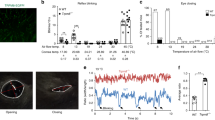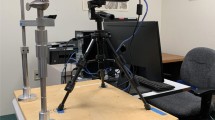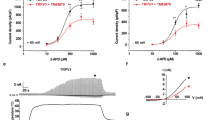Abstract
Basal tearing is crucial to maintaining ocular surface wetness. Corneal cold thermoreceptors sense small oscillations in ambient temperature and change their discharge accordingly. Deletion of the cold-transducing ion channel Transient receptor potential cation channel subfamily M member 8 (TRPM8) in mice abrogates cold responsiveness and reduces basal tearing without affecting nociceptor-mediated irritative tearing. Warming of the cornea in humans also decreases tearing rate. These findings indicate that TRPM8-dependent impulse activity in corneal cold receptors contributes to regulating basal tear flow.
This is a preview of subscription content, access via your institution
Access options
Subscribe to this journal
Receive 12 print issues and online access
$209.00 per year
only $17.42 per issue
Buy this article
- Purchase on Springer Link
- Instant access to full article PDF
Prices may be subject to local taxes which are calculated during checkout


Similar content being viewed by others
References
Moss, S.E., Klein, R. & Klein, B.E. Optom. Vis. Sci. 85, 668–674 (2008).
Tsubota, K. Prog. Retin. Eye Res. 17, 565–596 (1998).
Lehrer, S., Bogursky, E., Yemini, M., Kase, N.G. & Birkenfeld, A. Am. J. Obstet. Gynecol. 170, 835–837 (1994).
Dartt, D.A. Prog. Retin. Eye Res. 28, 155–177 (2009).
Purslow, C. & Wolffsohn, J. Optom. Vis. Sci. 84, 197–201 (2007).
Brock, J.A., McLachlan, E.M. & Belmonte, C. J. Physiol. (Lond.) 512, 211–217 (1998).
McKemy, D.D., Neuhausser, W.M. & Julius, D. Nature 416, 52–58 (2002).
Madrid, R. et al. J. Neurosci. 26, 12512–12525 (2006).
Kwan, K.Y. et al. Neuron 50, 277–289 (2006).
Bandell, M. et al. Neuron 41, 849–857 (2004).
Viana, F., de la Pena, E. & Belmonte, C. Nat. Neurosci. 5, 254–260 (2002).
Madrid, R. J. Neurosci. 29, 3120–3131 (2009).
Dhaka, A. et al. Neuron 54, 371–378 (2007).
Colburn, R.W. et al. Neuron 54, 379–386 (2007).
Belmonte, C., Brock, J.A. & Viana, F. Exp. Brain Res. 196, 13–30 (2009).
Acosta, M.C. et al. Invest. Ophthalmol. Vis. Sci. 45, 2333–2336 (2004).
Niederer, R.L., Perumal, D., Sherwin, T. & McGhee, C.N. Br. J. Ophthalmol. 91, 1165–1169 (2007).
Wolkoff, P., Nojgaard, J.K., Troiano, P. & Piccoli, B. Occup. Environ. Med. 62, 4–12 (2005).
Belmonte, C. J. Refract. Surg. 23, 598–602 (2007).
Acosta, M.C., Belmonte, C. & Gallar, J. J. Physiol. (Lond.) 534, 511–525 (2001).
Acknowledgements
We thank E. Quintero, A. Miralles, M. Bayonas, A. Estirado, S. Ingham and A. Pérez-Vegara for skillful technical assistance and P. Orio for help with the spike frequency analysis. The Trpa1−/− mice were a generous gift from D. Corey (Harvard Medical School). This work was supported by the Spanish MICINN: projects BFU2008-04425 to C.B., BFU2007-61855 to F.V., SAF2008-00529 to J.G., SAF2008-01004 to D.E. and CONSOLIDER-INGENIO 2010 CSD2007-00023, and by the Fundación de Investigación Oftalmológica, Instituto de Oftalmología Fernandez-Vega and Fundación M.C.- Masadeu-Peterson. R.M. thanks the support of FONDECYT-1100983.
Author information
Authors and Affiliations
Contributions
A.P. performed the electrophysiological experiments and their analysis and contributed to behavioral experiments in mice. R.M. contributed to the planning and development of the electrophysiological recordings and to the analysis of data and preparation of figures. D.E. and S.d.O. performed the histological work and figures. C.M.-P. generated the Trpm8-EYFP mice and carried out preliminary morphological work. M.A. and J.G. performed and analyzed the behavioral experiments in mice and humans. A.D. provided the Trpm8−/− mice. F.V. participated in the planning of the work and preparation of the manuscript. C.B. planned and directed the study, performed some of the experiments and wrote the paper.
Corresponding author
Ethics declarations
Competing interests
C.B., J.G. and F.V. have submitted a patent application with application number P201031341 (Pharmaceutical composition including TRPM8 ligands to treat dry eye), Spain.
Supplementary information
Supplementary Text and Figures
Supplementary Methods, Supplementary Figures 1–5, Supplementary Table 1 and Supplementary Results (PDF 8958 kb)
Rights and permissions
About this article
Cite this article
Parra, A., Madrid, R., Echevarria, D. et al. Ocular surface wetness is regulated by TRPM8-dependent cold thermoreceptors of the cornea. Nat Med 16, 1396–1399 (2010). https://doi.org/10.1038/nm.2264
Received:
Accepted:
Published:
Issue Date:
DOI: https://doi.org/10.1038/nm.2264
This article is cited by
-
TRPM channels in health and disease
Nature Reviews Nephrology (2024)
-
Association between mask-associated dry eye (MADE) and corneal sensations
Scientific Reports (2023)
-
Seasonal variations in presenting symptoms and signs of dry eye disease in Norway
Scientific Reports (2022)
-
TRPV1+ sensory nerves modulate corneal inflammation after epithelial abrasion via RAMP1 and SSTR5 signaling
Mucosal Immunology (2022)
-
Nobel somatosensations and pain
Pflügers Archiv - European Journal of Physiology (2022)



